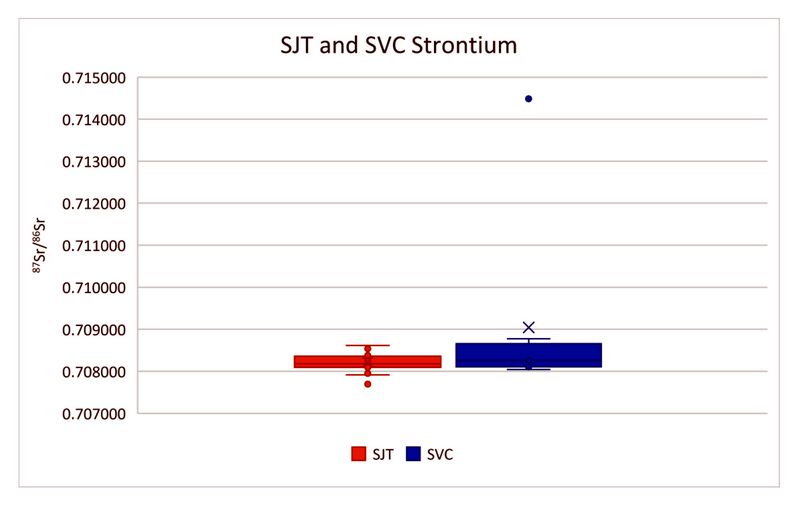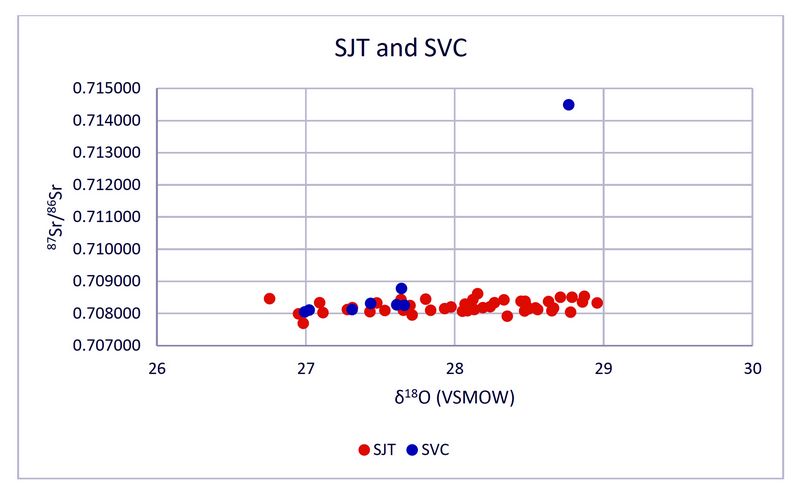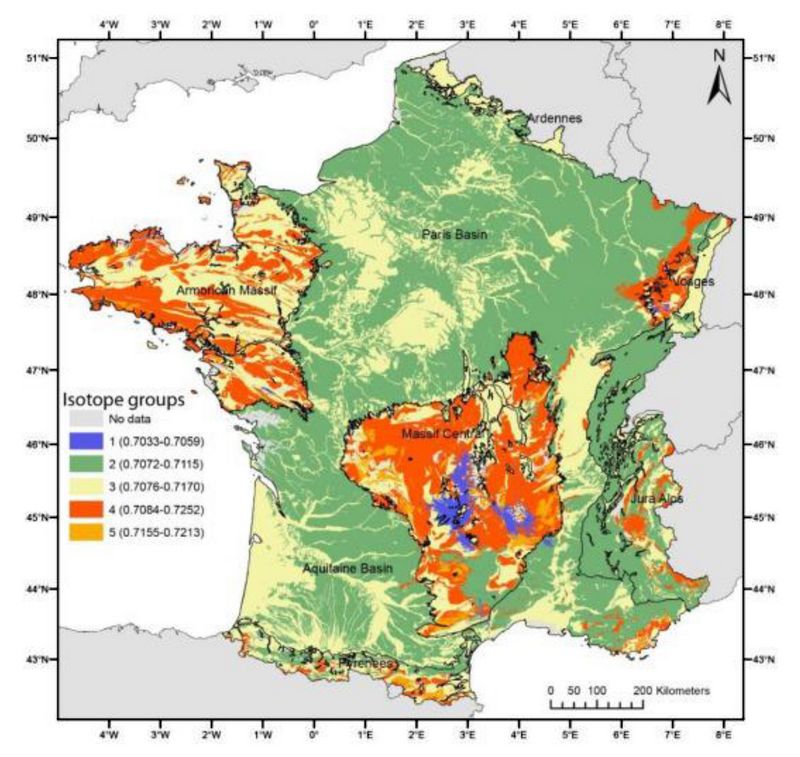Rust Family Foundation: Archaeology Grants Program
Saint-Jean
de Todon and Saint-Victor-la Coste: An Isotopic Comparison of Origins
Between the Medieval French Religious Elite and Lower-Class
Principal Investigator: Jane Holmstrom
University of Central Florida
This project investigates the origins of Medieval French individuals (9th – 13th century AD) buried in the elite cemetery of Saint-Jean de Todon and lower-status cemetery (9th – 13th century) of Saint-Victor-la-Coste, contemporaneous cemeteries that are in close geographical proximity (Figs. 1-2).
The Clunisian church of Saint-Jean de Todon (SJT) is located in Laudun l’Ardoise, Gard, France. The site, more recently known as Saint-Jean de Rouzigue, sits on the northeast side of Lacau, a limestone plateau, overlooking the Rhône River valley (Ardagna et al., 2010). While occupied since the Roman period, the northeast side of Lacau was predominantly used during the Medieval period. The church, however, exhibits several phases of construction beginning in the fifth century through the modern era (Ardagna et al., 2010; Jadaud, 2014). Of special note were religious pilgrims buried at Saint-Jean de Todon, identified by the presence of the scallop shell associated with Saint Jacques de Compostelle (Santiago de Compostela), located in northeastern Spain.
The church and cemetery site of Saint-Victor-la-Coste (SVC) is located in the valley approximately ten kilometers south from Saint-Jean de Todon. While used as early as the Early Bronze Age, continuous use of the site began around the 1st century BC until the present (Buffat et al., 2005). The church of Saint-Victor-la-Coste dates after the 12th century, but it is not known if it was rebuilt over an earlier building (Buffat et al., 2005).
Fig.1: Geographical location of Saint-Jean de Todon, Saint-Victor-la-Coste, and Saint-Jacque de Compostelle.
Previous Research at the sites.
The church site of Saint-Jean de Todon was completely excavated between 2002 and 2012 under the direction of Laurent Vidal (INRAP Archaeologist, Nîmes, France) and Yann Ardagna (Bioarchaeologist, Aix-Marseille University). All burials were located exteriorly on the west and south side of the church building. The skeletal remains of 226 individuals (140 males, 45 females, and 41 juveniles) were recovered. Radiocarbon dating indicates that the cemetery was in use between the second half of the 9th century until the end of the 13th century (Ardagna et al., 2010; Jadaud, 2014). Well-preserved burials were discovered in clearly defined tombs and minimal overlap (Ardagna et al., 2010; Jadaud, 2014). Burial style and paleopathological conditions indicate that high-ranking church officials and pilgrims were interred in this cemetery (Ardagna et al., 2012). Individuals identified as pilgrims were buried with the scallop shell associated with the pilgrimage to Saint Jacques de Compostelle (Almazán, 1996).
Fig.2: Ruins of Saint-Jean de Todon (photo: J. Holmstrom).
The cemetery at Saint-Victor-la-Coste was partially excavated from 1995-1997 by Hervé Petitot and the Tave Valley Archaeological Group (Buffat and Petitot, 2004). The partial excavation of the cemetery uncovered the remains of approximately 23 individuals (18 adults, 5 juveniles), believed to represent the lower-class in comparison to those buried at Saint-Jean. While the skeletons of Saint-Jean have been analyzed for pathological conditions of the post-cranial skeleton by Robert (2013), and for cranial and dental pathological conditions by Jadaud (2014), only preliminary analyses have been conducted on the skeletons of Saint-Victor-la-Coste. The PI is the first to utilize isotopic analysis on the individuals from both cemeteries.
.
2021 Funded Research Project (RFF-2021-159)
Goals:
The goals for this project were to answer the following two questions:
1) Can region of origin be identified for non-local individuals?
It is hypothesized that due to archaeological evidence of high status that there were non-local individuals buried in the Saint-Jean de Todon cemetery, while the Saint-Victor-la-Coste cemetery was likely used for the local lower-class community.
2) Are the Pilgrims distinguishable by their diet and origin?
It is also hypothesized that the pilgrims buried in the Saint-Jean de Todon cemetery were lower-class residents who increased their religious or spiritual social status through completion of the journey to the pilgrimage site of Saint Jacques de Compostelle in Spain. While they may have had an increased status during life, they may not have been buried with signs of privileged or wealthy status, such as grave-markers or stone-lined graves.
In addition, the aim of this project is to explore the impact of Christianity on diet and mobility during the Medieval period in southern France, a topic of minimal exploration, particularly pertaining to rural regions. Due to the geology of the area and the choice of burial location, the research provides a unique opportunity to explore cultural decisions concerning mobility of a broader community.
Methodologies:
A combination of techniques rarely employed together are utilized for this project. Isotope analysis, archaeological, and historical evidence, and GIS mapping were used together to not only tell the life story about Medieval Christians in southern France, but also present a visualization of the story.
A portion of the samples (N=50) were collected by the PI in 2019 for a pilot study that focused on preservation of the tissues. After preservation was determined to be excellent the remaining samples (n=156) were shipped to the PI by French collaborator, Dr. Yann Ardagna (Aix-Marseille University), during Fall 2020.
Current funding provided funds for strontium isotope analysis of 63 samples leading to the mapping and comparison of potential regions of origin for identified non-local individuals from Saint-Jean de Todon and Saint-Victor-la-Coste.
The project focused on the use of human tissues (teeth) to examine variation in mobility (strontium) among the elite and lower-class burials. Samples analyzed from Saint-Jean de Todon (n=55) represented males (n=34), females (n=9), non-adults (n=6), and 6 duplicates to test for analytical precision. Samples analyzed for strontium isotopes from Saint-Victor-la-Coste (n=8) represented males (n=3) and females (n=5).
Strontium isotope analysis was conducted at the Isotope Geochemistry Laboratory at the University of North Carolina at Chapel Hill by the PI with the assistance of Dr. Ryan Mills and Dr. Drew Coleman. Initial preparation of 63 samples was completed at the Laboratory for Bioarchaeological Sciences at the University of Central Florida by the PI. Tooth enamel was ground into powder using an agate mortar and pestle and screened through a 63µm graduated sieve. The enamel powder was weighed on a microbalance and at least 7 mg per sample was stored in a 2ml plastic centrifuge tube for further processing.
Samples were compared in reference to standard NBS 987, which has a ratio of 0.710250 ± 0.000010 (absolute, 2s) based on the replicate analyses of the standard run over the same period with the samples. The internal precision for individual strontium was ± 0.000003 to 0.000013 (absolute, 2s).
These strontium data will be combined with other mobility analyses (oxygen isotopes) to map potential regions of origin through GIS software. These data will then be compared with published data from other mortuary contexts in the region to explore questions of the intersection of religion, mobility, status, and social identity.

Fig.3: Boxplot of 87Sr/86Sr values for Saint-Jean and Saint-Victor. Note the outlier within the Saint-Victor group.
Preliminary Findings:
Regarding the question of whether the region of origin can be identified for non-local individuals:
From the combination of oxygen and strontium isotope analysis, the hypothesis that the individuals at SVC were local while those at SJT were non-local is supported. The strontium isotope data reveal that individuals interred in the SVC cemetery have a greater range in strontium values compared to those interred at SJT (Figures 3-4). Strontium isotope values range from 0.707692 to 0.714488 (x¯ = 0.709045) for SVC, and from 0.707916 to 0.708615 (x¯ = 0.708224) for SJT. The bioavailable strontium in France ranges between 0.702000-0.720000, varying based on the age of the geological structure, so these data suggest that the majority of individuals from SVC and SJT were likely from the local region or from a similar geological area within France. Although France’s range spans widely, there are distinct groupings of geology which can help to narrow down regions (Figure 5).

Fig.4: d18O VSMOW values with 87Sr/86Sr values for both Saint-Jean and Saint-Victor.
Since dental formation and eruption occur at consistent age intervals, teeth are useful for chronological aging, especially for non-adults. While the strontium isotope values suggest a local upbringing for most individuals, one individual appears to have moved to the area sometime after the age of eight as evidenced by their second molar. This individual, buried at SVC, was estimated to be an adult male between 35-45 years at time of death. Based on his strontium values alone, he may have come from within France, likely from a mountainous region, including the Pyrenees, French Alps, Massif Central, and Massif Armoricain (Voerkelius et al., 2010). Alternatively, he may have migrated from a mountainous region outside of France, like Spain (e.g., Sistema Central) or North Africa (e.g., Atlas) (Voerkelius et al., 2010; Scheuvens et al., 2013; Grousset et al., 1992). However, when utilizing an oxygen isoscape (Bowen et al. 2005), combined with his strontium isotope value, the estimated region of his origin is coastal Tunisia or a locality with similar geology, elevation, and climate (Bowen et al., 2005).

Fig.5: Map of France’s strontium isotopes as seen in Willmes et al., 2018.
When combining oxygen and strontium values for the other individuals from SVC, they do indicate a local upbringing. After combining oxygen values for those at SJT, a different picture emerges. There is evidence that some individuals are local to the immediate region, others are likely from greater France, but a few indicate values more consistent with coastal Spain, coastal Portugal, and coastal northern Africa (e.g., Morocco, Algeria, and Tunisia).
Regarding the question of whether the Pilgrims can be distinguishable by their diet and origin:
At present, only two of the nine identified pilgrims were available for strontium analysis. These individuals have been estimated to be older adult males at the time of death (40+ years old). Both indicate an upbringing outside of France but lived their last decade or so of life in the area of SJT. One had a grave marking, the other did not. Their carbon and nitrogen isotope values do not indicate a different diet or suggest any special status. While the two pilgrims are not distinguishable by their diet but likely had a different origin, they were most likely interred in the SJT cemetery due to their status as Pilgrims. It is not clear why one had been buried with a grave maker, but it is possible that this individual held some sort of symbolic status in life that was also transferred in death. The pilgrims do not have any isotopic indication that they held a more (or less) privileged life, as they had values very similar to others interred in the Saint-Jean cemetery. Without evidence of the scallop shell symbolizing the pilgrimage to Saint Jacque de Compostelle, the one without the grave marking would not be considered as especially unique. The hypothesis that the pilgrims were lower-class is neither supported nor unsupported. More work needs to be done to understand the status of pilgrims at Saint-Jean de Todon.
.Ongoing research:
This project is part of the PI’s dissertation research. All findings from this research project will be presented to the community of Laudun-l’Ardoise, France where the cemeteries are located. The overall dissertation project will be used as a foundation and comparison study for a new project the PI is currently developing, an isotopic study of individuals from a Medieval Convent in southern France, where the PI will be investigating religious gender differences in diet and mobility across Christian orders
Bibliography:
Almazán, V. (1996). The pilgrim-shell in Denmark. In: M. Dunn & L.K. Davidson (Eds.), The pilgrimage to Compostela in the Middle Ages: A book of essays, pp.131-142. Garland Publishing, Inc.
Ardagna, Y., Blanchard, D., Pelaquier, E., Vidal, L., & Seguin, M. (2010). Aux marges de l’ancienne agglomération antique du Camp de César: Saint-Jean de Todon alias Saint- Jean de Rousigue (Laudun-L’Ardoise, Gard). Archéologie du Midi Médiéval, 28, 161-180.
Ardagna, Y., & Vidal, L. (2012). Rouvrir, réduire, rallonger, reconstituer. Fossoyage dans le cimetière médiéval de Saint-Jean de Todon (Laudun-L’Ardoise, Gard). In: Guy, H., Jeanjean, A., Richier, A., Schmitt, A., Sénépart, I., & Weydert, N. Recontre autour du cadaver, actes du colloque de Marseille, Groupe d’Anthropologie et d’Archéologie Funéraire, décembre 2010, pp. 105-112.
Bowen, G.J., Wassenaar, L.I., & Hobson, K.A. (2005). Global application of stable hydrogen and oxygen isotopes to wildlife forensics. Oecologia, 143, 337-348.
Buffat, L., & Petitot, H. (2004). Saint Victor-la-Coste, ADLFI Archéologie de la France. Information (Online), Languedoc-Roussillon.
Buffat, L., Petitot, H., Vidal, L., Guerre, J., Masbernat-Buffet, A., & Pélaquier, E. (2005). Un center domanial dans la vallée de la Táve la villa de Mayran (Saint-Victor-la- Coste, Gard). Revue archéologique de Narbonnaise, 38-39, 225-279.
Grousset, F.E., Rognon, P., Coudé-Gaussen, G., & Pédemay, P. (1992). Origins of peri-Saharan dust deposits traced by their Nd and Sr isotopic composition. Palaeogeography, Palaeoclimatology, Palaeoecology, 93: 203–212.
Jaduad, R. (2014). Étude des caractères discrets crâniens et dentaires du cimetière Saint Jean de Todon à Laudun L’Ardoise (Gard, France). MA Thesis, Aix-Marseille Université.
Robert, L. (2013) Validation d’un protocole d’enregistrement des caractères discrets du squelette post-crânien: Application à la série du Gard provençal (Laudun). MA Thesis, Aix- Marseille Université.
Scheuvens, D., Schütz, L., Kandler, K., Ebert, M., & Weinbruch, S. (2013). Bulk composition of northern African dust and its source sediments – A compilation. Earth-Science Reviews, 116: 170-194.
Voerkelius, S., Lorenz, G.D., Rummel, S., Quetel, C.R., Heiss, G., Baxter, M., Brach-Papa, C., Deters-Itzelsberger, P., Hoelzl, S., Hoogewerff, J., Ponzevera, E., Van Bocxstaele, M., & Ueckermann, H. (2010). Strontium isotopic signatures of natural mineral waters, the reference to a simple geological map and its potential for authentication of food. Food Chemistry, 118: 933-940.
White, T.D., Black, M.T., & Folkens, P.A. (2012). Human Osteology. Academic Press.
Willmes, M., Bataille, C.P., James, H.F., Moffat, I., McMorrow, L., Kinsley, L., Armstrong, R.A., Eggins, S., & Grun, R. (2018). Mapping of bioavailable strontium isotope ratios in France for archaeological provenance studies. Applied Geochemistry, 90, 75-86.
.
Recent Foundation grants: general Archaeology Grants Program w/map
Copyright © 2022 Rust Family Foundation